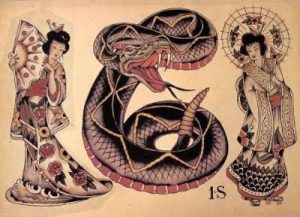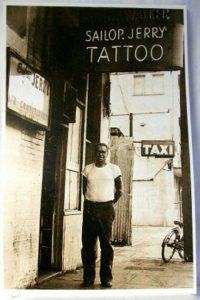Sailor Jerry’s Legacy Part II
Sailor Jerry evolved the traditions of American body art to a whole new level. He took the classic American flash style ready-made designs and incorporated inspiration from his times sailing across the Pacific. He corresponded with Japanese traditional tattoo masters and put his own spin and experience on what they would describe or share. He learned all techniques and traditions, such as incorporating water shading and background perspective, and turned it into his own, often with a distinctly American flair.

Far beyond anything anyone was doing
In a documentary on Sailor Jerry, another tattooing legend and Jerry’s protegé, Ed Hardy, describes seeing Jerry’s tattoos “like taking acid.” His pieces, Hardy says, were so far beyond in their complexity, sophistication and layout compared to anything anybody had done before. Jerry also researched all of the traditional images he would tattoo, which allowed him to expand on them authentically.
Purple ink, single needle and autoclave
To people’s amazement, Jerry managed to develop what everyone told him was impossible – purple ink. Legend says it came about when a neighbour of Jerry’s, whom he wasn’t overly fond of, kept telling him he would never be able to get a purple colour. And so Jerry set out to prove him wrong. If you or anyone you know has a purple shade on your tattoo, you have Sailor Jerry’s stubbornness to thank for it.
Jerry wasn’t done inventing things that would change the industry forever though. He became one of the first artists to utilise single needle, and he also came up with other custom needle formations that would cause less trauma to the skin.
When Jerry began tattooing, the notion of sterile workspace and the environment was far from the norm. In fact, there were no gloves, and no-one changed needles or ink. As one of the first tattoo shops in the world, Sailor Jerry’s Tattoo Shop began utilising an autoclave to sterilise equipment between clients. 
Heart attack on a Harley
Sailor Jerry passed away three days after suffering a heart attack while riding his Harley Davidson in June 1973. He instructed his wife that his shop should go to either Ed Hardy, Zeke Owen, or Mike Malone. If no-one of them wanted it, she should burn it to the ground. In the end, Ed Hardy did not want to leave Japan where he had been invited to practice with a master, Zeke declines, and so the shop went to Mike Malone who renamed it the China Sea Tattoo.
Extra Jerry trivia
Another little bit of trivia is that Sailor Jerry had his own radio show. From midnight to four am, reading his poetry, often patriotic and conservative, in a deep resounding voice. Other than that, he reportedly shunned publicity to any extent possible (compared to contemporary Lyle Tuttle, who ended up on the cover of Rolling Stone and with whom he an ongoing feud).
And even more extra trivia – just last year, Sailor Jerry’s widow Louise Collins sued the Scottish drink group, whiskey giant William Grant & Sons, for cashing in on her husband’s legacy after they purchased a rum brand with his name in 2008. The brand is one of the world’s largest rums, selling close to one million cases per year.
Whether you are tattooing or have a tattoo, you are part of a lineage and a tradition. It is worth knowing where it came from, and who are the people who are instrumental in its proliferation. Now hopefully you know a little more about one of modern tattooing history’s greats.
